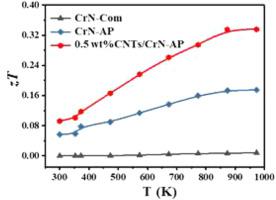Materials Today Physics ( IF 10.0 ) Pub Date : 2021-04-27 , DOI: 10.1016/j.mtphys.2021.100420 Min Yuan , Xueying Wan , Qinglong Meng , Xiaowei Lu , Lin Sun , Weihua Wang , Peng Jiang , Xinhe Bao

|
With the escalation of energy and environmental crisis, more and more attentions have been paid to the waste heat recovery, especially in the high-temperature range (>900 K). Chromium nitride (CrN) is expected to be a promising high-temperature thermoelectric material that can be used in harsh environments because of its high thermal stability, corrosion resistance and excellent mechanical properties. However, the relatively low figure of merit zT hinders its realistic applications. In this work, we reveal that the easily formed secondary phase Cr2N is one of the key factors restricting the CrN thermoelectric performance. Acid treatment is utilized to remove the metallic Cr2N phase from the commercially available powders. Nevertheless, after the sintering process at 1373 K, Cr2N phase can emerge again due to the decomposition of CrN. Interestingly, this decomposition process can be inhibited by introducing carbon nanotubes (CNTs), and the resulted hybrid material demonstrates greatly improved Seebeck coefficient and reduced thermal conductivity. A maximum zT value of 0.33 for the CNTs/CrN can be achieved at 973 K, which is 1.8 times as high as that of the acid-pickled CrN (0.18), and 40 times higher than that of the pristine chromium nitride (0.008). Additionally, the CNTs/CrN hybrid material exhibits outstanding mechanical hardness (11.5 GPa) as well as chemical and thermal stability. These results will promote the practical applications of CrN-based materials in the high-temperature thermoelectric field.
中文翻译:

抑制CrN基体中的次级相以提高高温热电性能
随着能源和环境危机的升级,废热回收越来越受到关注,尤其是在高温范围(> 900 K)中。氮化铬(CrN)由于其高的热稳定性,耐腐蚀性和出色的机械性能,有望成为有希望的高温热电材料,可在恶劣的环境中使用。然而,相对较低的品质因数zT阻碍了其实际应用。在这项工作中,我们揭示了容易形成的第二相Cr 2 N是限制CrN热电性能的关键因素之一。利用酸处理去除金属Cr 2N相由市售粉末制成。然而,在1373 K的烧结过程之后,由于CrN的分解,可能再次出现Cr 2 N相。有趣的是,可以通过引入碳纳米管(CNT)来抑制这种分解过程,并且所得的杂化材料表现出极大的塞贝克系数和降低的热导率。最大zT在973 K时,CNTs / CrN的数值为0.33,是酸洗CrN(0.18)的1.8倍,是原始氮化铬(0.008)的40倍。此外,CNTs / CrN杂化材料还具有出色的机械硬度(11.5 GPa)以及化学和热稳定性。这些结果将促进CrN基材料在高温热电场中的实际应用。











































 京公网安备 11010802027423号
京公网安备 11010802027423号